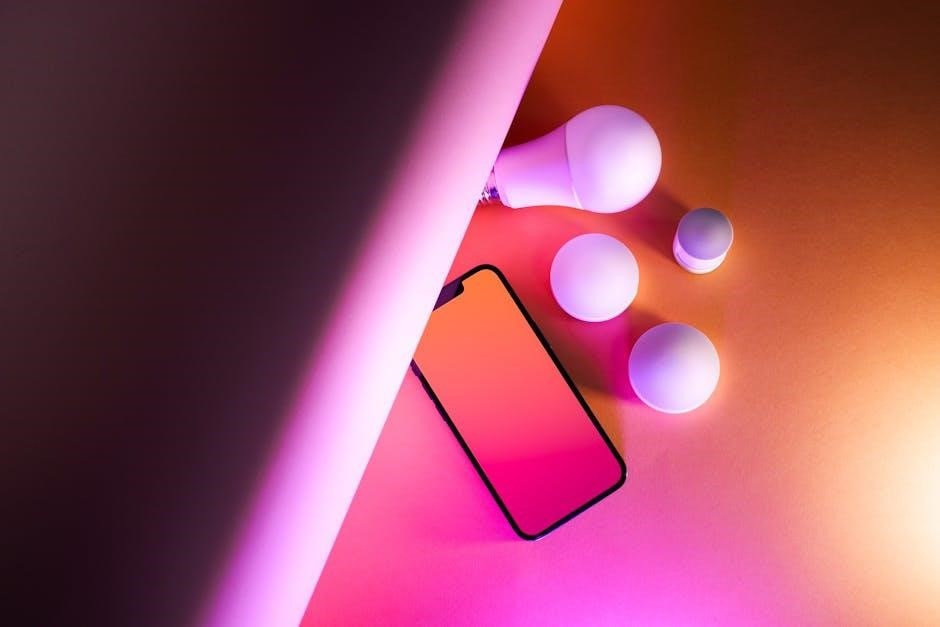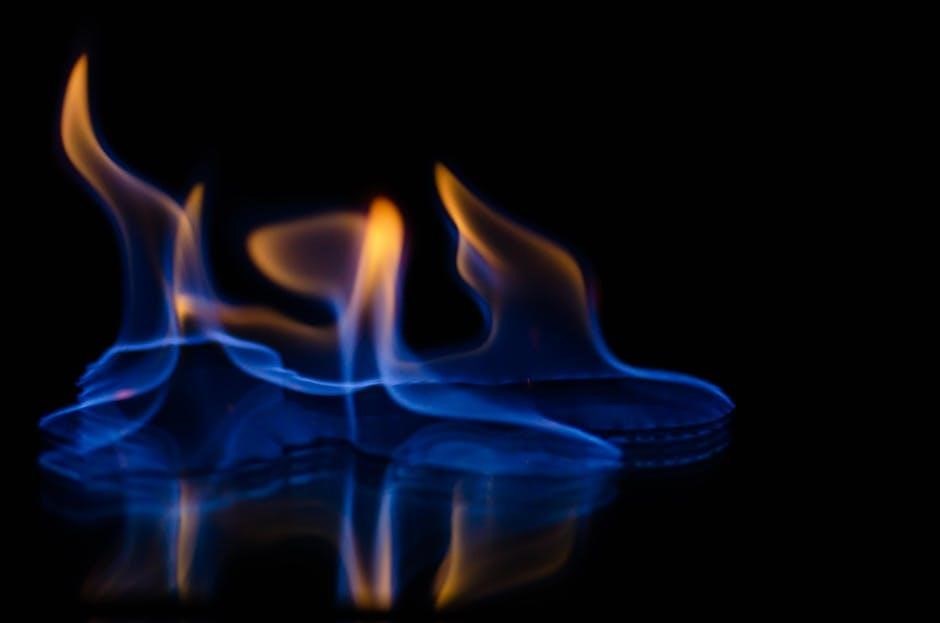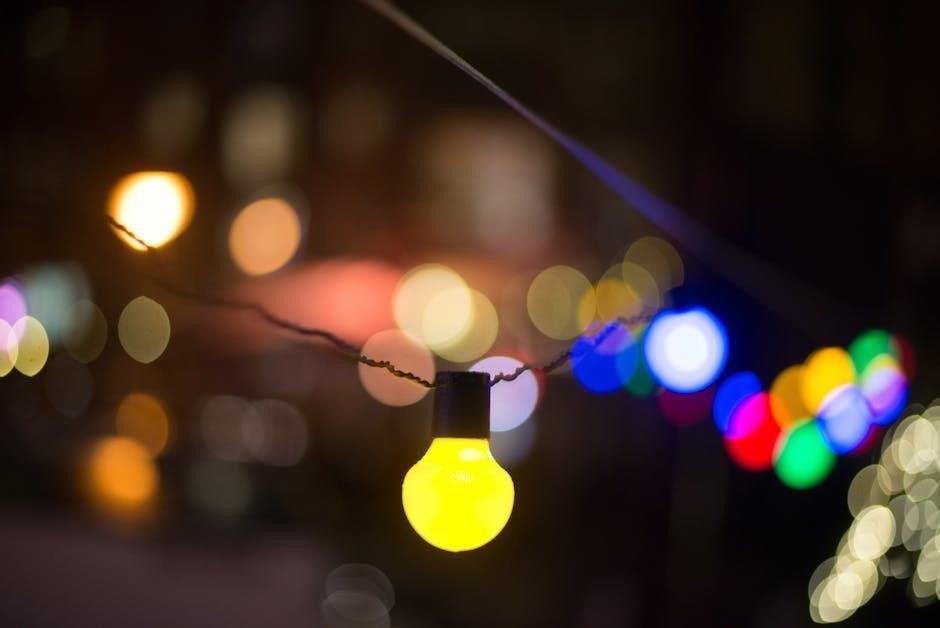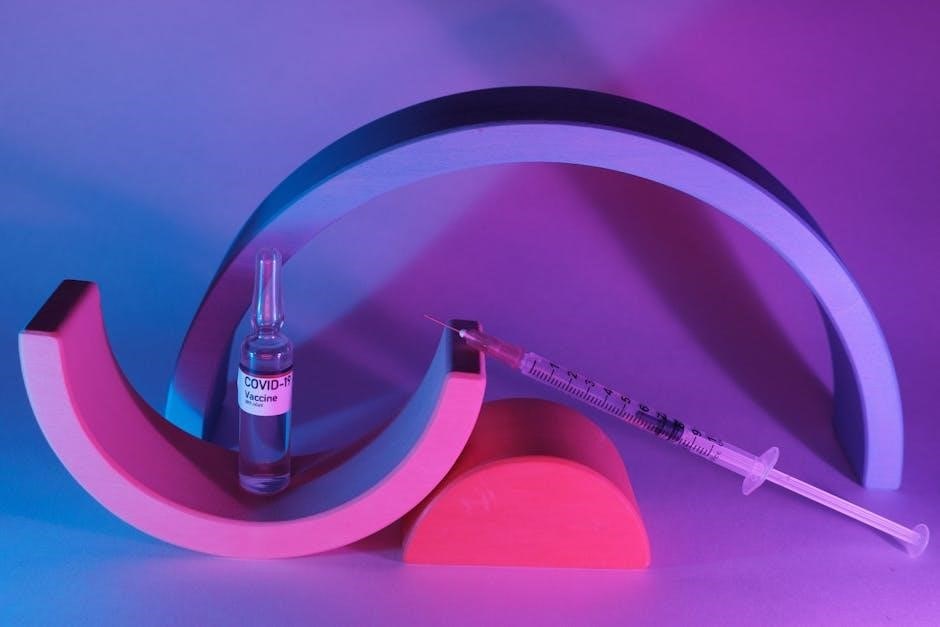Color temperature, measured in Kelvin (K), defines a light’s warmth or coolness․ Lower Kelvin values produce warm, yellowish hues, while higher values create cool, bluish tones․
This measure significantly impacts the ambiance and mood of a space, making it essential for selecting the right lighting for various settings and activities․
1․1 What is Color Temperature?
Color temperature, measured in Kelvin (K), refers to the warmth or coolness of light emitted by a bulb․ Lower Kelvin values (e․g․, 2700K) produce warm, yellowish tones, while higher values (e․g․, 5000K+) create cool, bluish hues․ This measurement reflects the light’s color, not its actual temperature․ The concept is based on the color of light emitted by a theoretical blackbody when heated․ In lighting, it helps determine the ambiance and mood a space will convey․ Understanding color temperature is crucial for selecting bulbs that align with specific lighting needs and preferences, whether for relaxation, productivity, or aesthetics․
1․2 The Kelvin Scale Explained
The Kelvin scale measures the color temperature of light, ranging from warm to cool tones․ Lower Kelvin values (2700K-3000K) represent warm, yellowish light, often described as cozy and relaxing․ Mid-range values (3000K-4100K) offer neutral to cool white light, suitable for task-oriented spaces․ Higher values (4100K-6500K) mimic daylight, providing bright, bluish-white illumination ideal for enhancing focus and clarity․ The scale helps consumers and designers choose bulbs that match their desired ambiance, ensuring the right balance between aesthetics and functionality․ This system simplifies the selection process, making it easier to achieve the perfect lighting atmosphere for any setting․
1․3 Importance of Color Temperature in Lighting
Color temperature plays a crucial role in lighting by influencing mood, productivity, and the visual appeal of a space․ Warm tones, often found in lower Kelvin ranges, create a relaxing atmosphere, making them ideal for living areas and bedrooms․ Cool tones, with higher Kelvin values, enhance focus and are commonly used in task-oriented environments like kitchens and offices․ The right color temperature can also highlight colors and textures, preserving the true appearance of objects․ Additionally, it impacts energy efficiency and comfort, with LED bulbs offering a wide range of color temperatures to suit different needs․ Understanding and selecting the appropriate color temperature ensures lighting that enhances both functionality and aesthetics in any setting․

Understanding Warm and Cool Light
Warm light emits a cozy, yellowish glow, ideal for creating relaxing environments, while cool light provides bright, bluish-white illumination, enhancing focus and clarity in task-oriented spaces․
2․1 Warm White Light (2700K-3000K)
Warm white light, ranging from 2700K to 3000K, produces a soft, yellowish glow reminiscent of traditional incandescent bulbs․ It creates a cozy and inviting atmosphere, often used in living rooms, dining areas, and bedrooms to promote relaxation․ This warm tone enhances wood and warm-colored interiors, making spaces feel more welcoming․ It is also known to reduce eye strain in low-light conditions, making it ideal for reading or ambient lighting․ Warm white light is a popular choice for residential settings where comfort and aesthetics are prioritized over task-oriented illumination․ Its gentle warmth mimics natural daylight at sunset, fostering a calming environment for unwinding and socializing․
2․2 Cool White Light (3500K-5000K)
Cool white light, spanning 3500K to 5000K, emits a bright, crisp glow with a slight blue tint․ It is ideal for task-oriented spaces like kitchens, bathrooms, and work areas, where clarity and focus are essential․ This range enhances visibility and detail, making it suitable for reading or precision tasks․ Cool white light is also energizing, often used in commercial settings to boost productivity․ It complements modern interiors with its neutral to cool tones․ Unlike warm white, cool white is less about ambiance and more about functionality, providing a clean, refreshing illumination that keeps spaces lively and active․ Its versatility makes it a popular choice for environments requiring both efficiency and visual clarity․
2․3 Daylight (5000K-6500K)
Daylight bulbs, ranging from 5000K to 6500K, mimic natural outdoor light, offering a crisp, neutral-to-blueish hue․ This range is ideal for tasks requiring high accuracy, such as reading, drafting, or detailed work, as it enhances clarity and reduces eye strain․ Daylight bulbs are also known to boost alertness and energy levels, making them perfect for use in the morning or in spaces where focus is crucial․ They are commonly used in task lighting, outdoor setups, and commercial environments․ However, their intense brightness may feel too harsh for cozy or relaxing spaces․ For those seeking a light closest to natural daylight, this range is the optimal choice, providing a clean, invigorating illumination that closely resembles the sun’s rays․

Color Temperature Ranges
Color temperature ranges categorize light from warm to cool tones, guiding selections for ambiance, task efficiency, or energy savings, ensuring optimal lighting for any setting․
3․1 Soft White (2700K-3000K)
Soft White light, ranging from 2700K to 3000K, offers a warm, cozy ambiance, ideal for residential spaces․ It mimics traditional incandescent bulbs, creating a relaxing atmosphere․ Perfect for living rooms, bedrooms, and dining areas, Soft White enhances warm-toned interiors and complements wood accents․ Its gentle glow reduces eye strain, making it suitable for reading or ambient lighting․ However, it may not be the best choice for task-oriented spaces requiring bright, focused light․ With a Color Rendering Index (CRI) often above 80, it provides decent color accuracy․ Energy-efficient options like LED bulbs in this range are popular for their warm aesthetics and long lifespan, though they may not be as bright as cooler tones․
3․2 Bright White (3000K-3500K)
Bright White, spanning 3000K to 3500K, offers a balanced blend of warmth and clarity, making it ideal for spaces requiring both ambiance and functionality․ It is slightly brighter than Soft White but still maintains a warm, inviting feel․ This range is perfect for kitchens, bathrooms, and task-oriented areas like reading nooks or workspaces․ Bright White enhances neutral and cool-toned interiors while providing sufficient light for everyday activities․ With a moderate Color Rendering Index (CRI), it ensures colors appear natural and vibrant․ LED bulbs in this range are energy-efficient and durable, making them a practical choice for homeowners seeking a versatile lighting solution that combines aesthetics with performance․
3․3 Cool White (3500K-4100K)
Cool White, falling between 3500K and 4100K, offers a crisp, neutral light with a slight blue undertone․ This range is ideal for task-oriented spaces like offices, garages, or workshops, where clarity and focus are essential․ It enhances alertness and is often used in commercial settings to create a professional atmosphere․ Cool White bulbs are highly energy-efficient and provide bright illumination, making them suitable for overhead lighting or under-cabinet setups․ They work well in modern, minimalist interiors and are a popular choice for those who prefer a clean, neutral ambiance․ This range strikes a balance between warmth and brightness, offering functionality without sacrificing comfort․
3․4 Daylight (4100K-6500K)
Daylight bulbs, ranging from 4100K to 6500K, mimic natural outdoor light, offering a bright, invigorating ambiance․ This range is ideal for task lighting, reading, or areas requiring high concentration, such as study rooms or kitchens․ Daylight bulbs are known for their clarity and ability to reduce eye strain, making them popular for detail-oriented tasks․ They are also commonly used in display lighting to enhance the appearance of colors and objects․ With a cool, refreshing tone, daylight bulbs create a stimulating environment, often used in commercial and medical settings․ Their high color temperature ensures maximum alertness and energy, making them a great choice for spaces needing a vibrant, energizing atmosphere․

Psychological and Aesthetic Impact
Color temperature significantly influences mood, ambiance, and visual appeal; Warm tones create relaxation, while cool tones enhance alertness․ The right balance can elevate a space’s aesthetic and functionality․
4․1 Effects on Mood and Ambiance
Color temperature profoundly impacts mood and ambiance, shaping the emotional atmosphere of a space․ Warm white lighting (2700K-3000K) fosters relaxation and coziness, ideal for living areas or bedrooms, while cool white and daylight tones (3500K-6500K) enhance alertness and energy, perfect for kitchens or home offices․ The psychological influence of light can reduce stress, improve focus, or create a calming environment․ By selecting the right color temperature, spaces can be tailored to specific activities or moods, ensuring a harmonious balance between functionality and aesthetics․ This subtle yet powerful aspect of lighting design plays a crucial role in enhancing overall well-being and user experience․
4;2 Color Rendering Index (CRI)
The Color Rendering Index (CRI) measures how accurately a light source displays colors compared to daylight․ Ratings range from 0 to 100, with higher values indicating better color accuracy․ A high CRI is essential for tasks requiring precise color perception, such as cooking, reading, or makeup application․ Lighting with a CRI of 80 or above is considered good for most residential and commercial applications, while 90+ is ideal for spaces needing high color fidelity, like art galleries or retail displays․ CRI works alongside color temperature to create visually comfortable environments, ensuring that colors appear natural and vibrant under artificial light․
4․3 Task-Specific Lighting Needs
Task-specific lighting needs vary depending on the activity being performed․ For reading or detailed work, cool white light (3500K-5000K) is often preferred as it enhances focus and reduces eye strain․ Warm white light (2700K-3000K) is ideal for relaxation and ambient settings, creating a cozy atmosphere․ In kitchens, daylight (5000K-6500K) is recommended for its bright, neutral tone, which aids in precise tasks like cooking․ Additionally, color temperature should align with the task’s requirements: warmer tones for living areas and cooler tones for workspaces․ Balancing color temperature with task-specific needs ensures optimal functionality and comfort, making it easier to tailor lighting to individual preferences and activities․ Proper selection enhances productivity and overall satisfaction in any setting․

Applications of Different Color Temperatures
Different color temperatures are applied in residential, commercial, and outdoor settings to enhance ambiance, productivity, and safety․ Warm tones create cozy homes, while cool tones suit workplaces and public areas, improving focus and visibility․ Daylight tones are ideal for task-oriented spaces like kitchens or reading areas․ Outdoor lighting often uses cool or daylight tones for security and clarity․ By matching color temperature to the setting’s purpose, lighting can optimize functionality, aesthetics, and user experience, ensuring the right atmosphere for every application․ This tailored approach maximizes the benefits of lighting in various environments․
5․1 Residential Lighting
In residential settings, color temperature plays a crucial role in creating the desired ambiance and functionality․ Warm white tones (2700K-3000K) are ideal for living rooms and bedrooms, fostering relaxation and coziness․ Cool white tones (3500K-4100K) are often used in kitchens and bathrooms, where task-oriented lighting is essential․ Daylight tones (5000K-6500K) are perfect for reading areas or home offices, enhancing focus and clarity․ The choice of color temperature depends on the room’s purpose and the mood homeowners wish to create․ By selecting the right tone, residents can tailor their lighting to suit their lifestyle, ensuring both comfort and practicality in every space․
5․2 Commercial Lighting
In commercial spaces, color temperature significantly impacts productivity, ambiance, and customer experience․ Cool white tones (3500K-5000K) are commonly used in offices and retail settings to enhance alertness and focus, while daylight tones (5000K-6500K) are ideal for task-oriented areas requiring high concentration․ Warm white tones (2700K-3000K) create a welcoming atmosphere in restaurants and cafes․ The choice of color temperature should align with the space’s purpose, ensuring optimal functionality and aesthetics․ Consistency in lighting is crucial for a professional environment, though mixing temperatures can be beneficial in diverse spaces․ Energy-efficient LED bulbs are recommended, and smart lighting solutions offer adjustable temperatures for dynamic environments․ Consider the Color Rendering Index (CRI) for accurate color representation, especially in retail․ This ensures products appear appealing, enhancing the overall commercial experience․
5․3 Outdoor Lighting
Outdoor lighting color temperature plays a crucial role in functionality, safety, and aesthetics․ Cool tones (3500K-6500K) are often preferred for their bright, crisp light, enhancing visibility and security in parking lots, streets, and pathways․ Daylight tones (5000K-6500K) mimic natural light, reducing eye strain and improving clarity․ Warm tones (2700K-3000K) are ideal for residential exteriors, creating a welcoming ambiance while blending with architectural designs․ For commercial outdoor spaces, such as storefronts, a balance between cool and warm tones ensures both visibility and an inviting atmosphere․ LED bulbs are highly recommended for outdoor use due to their durability and energy efficiency․ Consider environmental factors, like minimizing light pollution, by using warmer tones or shielded fixtures․ Proper color temperature selection ensures safety, aesthetic appeal, and functional performance in outdoor settings․

Choosing the Right Color Temperature

Selecting the ideal color temperature involves understanding the space’s purpose, desired ambiance, and specific tasks․ Consider room function and personal preference to create optimal lighting conditions․
6․1 Understanding Lumens and Kelvins
When selecting the right color temperature, it’s essential to understand the relationship between lumens and Kelvins․ Lumens measure brightness, while Kelvins indicate color temperature․ Higher lumens mean more brightness, but they don’t affect color quality․ The Kelvin scale ranges from warm (2700K-3000K) to cool (3500K-6500K)․ Combining the right lumen output with your preferred Kelvin rating ensures both brightness and ambiance needs are met․ For example, a warm white bulb (2700K-3000K) with lower lumens creates a cozy feel, while a cool white bulb (3500K-4100K) with higher lumens is ideal for task-oriented spaces․ Balancing these factors ensures optimal lighting for any setting․
- Lumens: Measure of brightness․
- Kelvins: Measure of color temperature․
- Combine both for ideal lighting conditions․
6․2 Color Temperature and Room Function
Color temperature plays a crucial role in defining the ambiance and functionality of different spaces․ Warm white light (2700K-3000K) is ideal for living rooms and bedrooms, creating a cozy and relaxing atmosphere․ Cool white (3500K-4100K) and daylight (4100K-6500K) are better suited for kitchens, bathrooms, and home offices, where task-oriented lighting is essential․ The choice of color temperature should align with the room’s primary function, ensuring both comfort and efficiency․ For instance, soft white bulbs enhance dining areas, while bright white or cool tones are perfect for reading or working․ Matching the right color temperature to the room’s purpose ensures optimal lighting for every activity․
- Warm white for relaxation and comfort․
- Cool white and daylight for task-oriented spaces․
- Align temperature with room function for best results․
6․3 Dimmability and Color Consistency
Dimmability and color consistency are essential factors when selecting light bulbs, as they directly impact the lighting experience․ Dimmable bulbs allow adjustments in brightness, providing flexibility for different settings․ However, not all bulbs maintain their color temperature when dimmed, as some may shift to warmer tones․ High-quality dimmable LEDs are designed to preserve color consistency, ensuring the light’s hue remains stable even at lower brightness levels․ This feature is particularly important for maintaining the desired ambiance in a room․ For optimal results, look for bulbs with a high color rendering index (CRI) and compatibility with dimmer switches․ Balancing dimmability and color consistency ensures a seamless lighting experience tailored to specific needs․
- Dimmable bulbs offer adjustable brightness for versatility․
- Color consistency ensures the hue remains stable when dimmed․
- Choose high-quality LEDs for reliable performance․

LED Technology and Color Temperature
LEDs use semiconductors to emit light across a spectrum of color temperatures, from warm to cool tones, enhancing energy efficiency and lifespan․
7․1 How LED Bulbs Produce Different Color Temperatures
LED bulbs achieve varying color temperatures through their semiconductor technology and phosphor coatings․ A blue LED chip emits light that passes through a phosphor layer, which converts some of the blue light into other wavelengths, creating a broader spectrum․ The thickness and composition of the phosphor coating determine the color temperature․ For example, a thicker phosphor layer produces warmer tones (e․g․, 2700K-3000K), while a thinner layer allows more blue light to dominate, resulting in cooler temperatures (e․g․, 5000K-6500K)․ This precise control enables LEDs to mimic traditional incandescent bulbs while maintaining high energy efficiency and design flexibility․
7․2 Energy Efficiency and Color Temperature
Energy efficiency in LED bulbs is closely tied to their color temperature․ LEDs with higher color temperatures (cooler light, e․g․, 5000K-6500K) generally consume less energy than those with lower color temperatures (warmer light, e․g․, 2700K-3000K)․ This is because cooler tones rely more on the natural emission of the blue LED chip, requiring less energy-intensive phosphor conversion․ In contrast, warmer tones need a thicker phosphor coating to convert blue light into yellow/red wavelengths, which reduces overall efficiency․ However, advancements in LED technology have narrowed this gap, allowing warm white LEDs to remain highly energy-efficient compared to traditional incandescent bulbs․ Balancing color temperature and energy efficiency is key to selecting the right LED for specific lighting needs․
7․3 Lifespan of LED Bulbs by Color Temperature
The lifespan of LED bulbs can vary slightly depending on their color temperature․ Generally, LEDs with cooler tones (3500K-6500K) may have a marginally shorter lifespan compared to warmer tones (2700K-3000K)․ This is because cooler color temperatures often involve more intense blue light emission, which can cause the phosphor coating to degrade faster over time․ However, advancements in LED technology have minimized these differences, ensuring that all color temperatures maintain a long lifespan of 25,000 to 50,000 hours or more․ Proper heat management and high-quality materials also play a significant role in preserving the longevity of LED bulbs, regardless of their color temperature․ Thus, while slight variations exist, LEDs remain highly durable across all color temperature ranges․

Selecting the Best Bulb for Your Needs
Selecting the best bulb involves considering color temperature, brightness, and energy efficiency․ LED bulbs are a popular choice due to their long lifespan and versatility․ Always consider room function and personal preference when making your decision;
8․1 A Comprehensive Buying Guide
When selecting the best bulb for your needs, start by assessing the room’s function and lighting requirements․ Consider the color temperature that matches the ambiance you desire, whether warm, cool, or daylight․ Check the lumen rating to ensure adequate brightness, and compare it to the wattage of your existing bulbs for energy efficiency․ LED bulbs are highly recommended for their long lifespan and energy-saving benefits․ Look for certifications like Energy Star to ensure quality and efficiency․ Additionally, consider dimmability if you plan to use the bulb with a dimmer switch․ Finally, evaluate the Color Rendering Index (CRI) for accurate color representation․ Always read reviews and compare brands to find the best value for your specific needs․
8․2 Tips for Mixing Color Temperatures
Mixing color temperatures can enhance the ambiance of a space by creating visual interest and functional lighting zones․ Start by designating different areas for specific tasks, such as using warm white (2700K-3000K) for relaxation areas and cool white (3500K-5000K) for task-oriented zones․ Layer lighting by combining ambient, task, and accent lights with varying temperatures․ Use dimmable bulbs to adjust brightness and blend colors seamlessly․ Consider the 60-30-10 rule: 60% ambient, 30% task, and 10% accent lighting․ Ensure consistency by selecting bulbs with a high Color Rendering Index (CRI) for accurate color representation․ Finally, test combinations in your space to find a harmonious balance that meets both aesthetic and functional needs․
8․3 Maintenance and Replacement Tips
Regular maintenance ensures optimal performance and longevity of your light bulbs․ Dust bulbs periodically to prevent dimming and heat buildup, which can alter color temperature․ Replace bulbs before they burn out completely to maintain consistent lighting quality․ Consider upgrading to energy-efficient options like LEDs, which retain color temperature better over time․ Check for flickering or color shifts, as these indicate a bulb may need replacement․ Always follow the manufacturer’s guidelines for usage hours and environmental conditions to maximize lifespan․ Finally, keep spare bulbs on hand to avoid sudden lighting disruptions․ Proper care ensures your lighting remains both functional and aesthetically pleasing․

Future Trends in Lighting Color Temperature
Future trends include smart lighting with adjustable color temperatures, eco-friendly LED innovations, and advanced dimming technologies for seamless ambiance control, enhancing both energy efficiency and aesthetic appeal․
9․1 Smart Lighting and Adjustable Color Temperature
Smart lighting systems are revolutionizing how we experience color temperature, offering unparalleled control through voice commands or smartphone apps․ These systems enable seamless transitions between warm and cool tones, adapting to daily routines and preferences․ By integrating sensors and AI, smart bulbs can automatically adjust color temperature based on ambient light or time of day, enhancing energy efficiency and ambiance․ Additionally, these systems often support circadian rhythm lighting, mimicking natural daylight patterns to improve well-being․ With the ability to customize and schedule lighting scenes, smart technology is redefining how color temperature is used in modern spaces, blending convenience, sustainability, and aesthetic appeal․
9․2 Sustainability and Eco-Friendly Options
Sustainability is a key consideration in modern lighting solutions, with color temperature playing a role in energy efficiency․ LED bulbs, known for their long lifespan and low energy consumption, are increasingly popular for their eco-friendly benefits․ Cool white and daylight color temperatures often align with energy-saving goals, as they provide bright illumination with minimal power use․ Additionally, eco-friendly lighting options may include bulbs made from recyclable materials or those free from harmful substances like mercury․ Choosing sustainable lighting not only reduces environmental impact but also supports long-term energy savings, making it a vital aspect of responsible lighting choices for both residential and commercial spaces․
9․3 Emerging Technologies in Lighting
Emerging technologies in lighting are revolutionizing how we experience and interact with light․ One notable advancement is Li-Fi, which uses light waves to transmit data, offering faster internet connectivity while maintaining energy efficiency․ Quantum Dot technology is another breakthrough, enhancing color accuracy and consistency across different color temperatures․ Additionally, advancements in adaptive lighting systems allow for dynamic color temperature adjustments based on time of day or ambient conditions, improving user comfort and energy savings․ These innovations not only expand the possibilities for color temperature customization but also align with sustainable and eco-friendly practices, ensuring lighting solutions remain cutting-edge and environmentally responsible․
